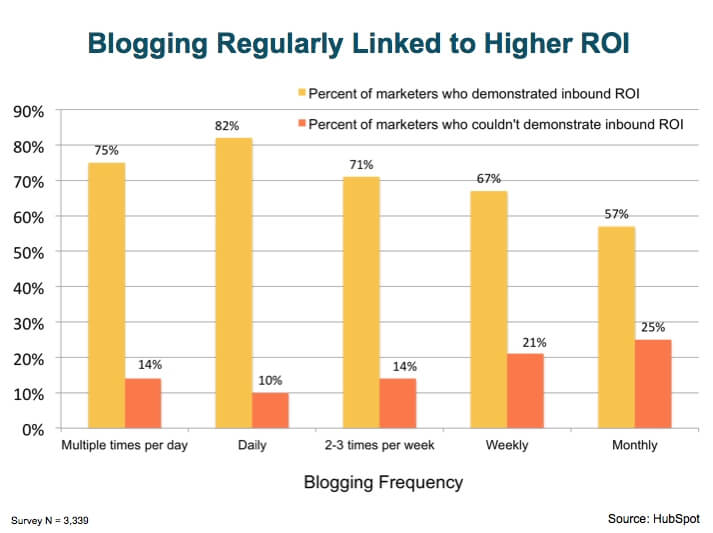Ah, Bad habits. They make you or break you.
It’s no less true for bloggers. I’ve seen a lot of promising bloggers who put off writing down their best ideas until someone else has beaten them to it. Others let distractions destroy their passion.
There are other counterproductive habits that are worth discussing. The goal of this article is to help you get back on the blogging track by determining which bad habits is causing you serious problems.
Like with anything in life, content writing is vulnerable to the development and persistence of some very bad habits. Bad habits in the writing, publishing, and syndication of your exact same content can interfere with your overall quality, the long-term viability of your campaign, and of course the size and loyalty of your readership.
Fortunately, your content marketing is an ever-evolving entity, and no matter how long these habits have been forged, it’s possible to break them if you are aware of them and have committed yourself to the process.
If you catch yourself involved in any of these five terrible content Marketing habits, it’s time to reevaluate your strategy and try to move past them:
Table of Contents
1. Irregular Posting Frequency
Skipping posts is a perennial problem among newbie bloggers. The danger of posting inconsistently is that it’s a surefire way to annoy visitors who have developed a liking for your blog. If you intend to attract a steady stream of loyal followers over time, be sure to post on a regular basis.
How regularly should you post to your blog? It depends on you. You could update your blog daily, two or three times a week, or every business day. No matter what schedule you choose, stick to it religiously.
One of the biggest benefits of posting regularly is that content freshness plays into search ranking. The more you post fresh relevant content, the more the search engines will give you favorable rankings.
The importance of consistency in a content marketing program cannot be understated.

While each of your articles needs to be a unique piece, they also need to fall in line with a consistent voice, a consistent feel, and a consistent schedule.
Small business owners especially have a hard time maintaining a consistent publication schedule. Since content marketing may not be a primary concern and resources are scarce (some entrepreneurs take it upon themselves to do all the web optimized writing for their business), the publication of articles becomes random, based on their whims and business circumstances.This kind of inconsistency makes it impossible to build a loyal audience—unpredictable publications means nobody knows when to check back for more updates.
Focusing on inconsistent topics can also be a problem, especially if you meander outside your business’s realm of expertise. It’s important to have a diversity of topics available for your disposal, but you’ll also want to become known as an expert in a specific niche—if you can’t, your business might fall into a pit of irrelevance with overly general or non-specifically written material. Having a consistent brand voice can be the glue to hold your separate topics together—make sure you have an outline and a plan for it, especially if you’re using multiple writers.
Ran out of ideas to blog about? Here’s a great list to keep the creative copywriting juices flowing.
2. Ignoring Visitors
Nothing is more rewarding for bloggers than seeing readers visit their blogs regularly. If you’ve developed regular followers for your blog, let them know you’re thankful by acknowledging them.
Make a point of appreciating them by posting a tweet about it, moderating comments, etc. And if people are tweeting your posts, return the favor by tweeting their content marketing or simply posting a shout-out or tweet that acknowledges their attention.
Make acknowledging your visitors a regular habit, not only to build solid loyalty among your followers but also to develop a healthy two-way relationship from which both you and your readers will benefit.
3. Paying Too Much Attention to Stats
Paying attention to stats is a great and best way to learn how you’re doing and how to improve your blog. It gives you insight as to where visitors are coming from and which keywords they’ve used to find you.
However, you should not obsess over the numbers. It’s counterproductive. Over-analyzing your stats eats up precious time that could be used to produce further great content.
If you create great content on a constant basis, the numbers will take care of themselves.
4. Obsessing Over Social Networking & Link Building
Sure, it’s great to create relationships with followers via Facebook and Twitter. It’s also a great idea to pursue some marketing on social media platforms so your blog will gain exposure to even more eyeballs.
However, don’t trade your blogging how much time for social networking time. You must continue to dedicate a sufficient bloc of your time to thinking, research, and composing great content. Focus on constantly creating excellent content for your audience, and if your content is worthy enough to go viral, loyal readers and one-time visitors will take care of doing the marketing for you.
To deal with this problem, set a time for blogging and a separate time for social media interactions. Schedule your blogging activities for the part of the day when you feel most productive.
Stick to this routine to continue producing high quality and useful content for your audience.
The backlinks will come.
If they don’t, you can increase your knowledge on how to build links with our SEO link building guide.
The rest of your time should be free for you to do as you please, but be sure to acknowledge your visitors and interact with them on social media.
5. Limiting Your Content to Newsjacking and Content Borrowing.
Let’s get one thing straight here: newsjacking can be a valuable part of your content Marketing strategy, as long as it’s only part of it. Newsjacking, the process of scouting the news for articles relevant to your business and repurposing (or worse–duplicating) the article to be valuable to your readers, is useful because it takes a smaller degree of effort than most articles (since the bulk of the content marketing already exists in some form) and because of its timeliness and relevance. However, once you’ve newsjacked a series of articles, you might become accustomed to the workflow and proceed to newsjack the majority of your new posts.
The same bad habit can occur when you browse your competitors’ blogs for inspiration. Rather than reading up on new material, thinking about it, and brainstorming your own new topics, you might get used to cherry picking new topics directly from outside sources.
While these BAd habits might allow you to skate by Google’s algorithms and impress your users for a limited time, if this represents the entirety of your content Marketing and content strategy, you’ll be setting yourself up for destruction. You’ll never be able to become an authority in your respective field if you don’t have a sizeable contribution of unique content—material, facts, and opinions that users can’t get anywhere else. Feel free to leave newsjacking as a component of your strategy, but don’t neglect the importance of originality.
6. Writing More Than You Read.
This is a critical mistake of writers everywhere, not just content marketers. The only way to get better at writing is to read. Otherwise, you’ll fall into a close-minded, repetitive way of thinking and writing, and you’ll never learn to surpass your own skills. Reading opens the door to new opinions, new ideas, and new styles of writing that can influence you and help you grow in the right directions. Otherwise, you’ll be stuck in stagnation.
It’s easy to lose the habit of reading, especially as you become more versed in your field of expertise and more confident in your abilities to churn out blogs. But even the most conservative industries change often, and staying up-to-date with the latest content can keep you ahead of the curve. Make sure you subscribe to several major publications, including the blogs of your competitors, industry news sites, and national news sites. Read several articles a day if you can, and try to learn something new in every article—even if it’s just a fact or a new means of presenting information in your body copy.
7. Using the Same Format, Every Time.
Content marketing has evolved beyond the need to replicate the same written article format with every post. While written content is still valuable because of the sheer volume of scannable text that is presented to major search engines, users crave a more integrated experience.
For example, instead of posting a traditional written article, you could write a step-by-step guide with images accompanying each step of the process. Or, you could break the article down into bullet-point reminders, and post an accompanying video to demonstrate the process. Experiment with different formats for your article content as well; instead of relying on a step-by-step guide format, a list-based format, or a header-and-subheader based format, you could vary it up by including new formats for each new entry.
When you start your blog and begin writing blog posts regularly, following the same format becomes an easier way to manage the process. However, it will ultimately work against your campaign. Diversify your formatting in order to appeal to the widest possible audience and preserve the interest of your current following.
8. Failing to Listen to Your Audience.
Your content marketers and content marketing strategy cannot remain stagnant; it needs to grow to meet the needs and desires of your customers. After writing for long enough, it’s easy to develop a habit of focusing on your own means of production, rather than on your readers’ perspectives. However, this can be damaging to your bottom line. The most successful content marketing programs on the web are the ones that actively take their readers’ opinions into consideration.
Read your users’ comments often, and respond whenever you can to build the conversation.
Feel free to ask your users directly what they like and don’t like about your blog, and what they’d like to read about in the future. You can even go a step further and conduct formal surveys to learn more about your audience and cater to them. When you write with your readers in mind, you’ll be far more successful in the long run.
Habits take a long time to form, so it’s only natural that they’ll take a long time to break. This bad habit can result in a serious burden for your content marketing campaign, so it’s essential that you get rid of them eventually, but try not to get discouraged if you find it difficult at first.
Instead of trying to break all of them at once, focus on one bad habit at a time, and make a series of gradual changes to improve upon that area of your campaign. When you break the process down into a series of manageable, actionable steps, you’ll have a much easier time triumphing over these bad habits and restoring your content marketing strategy to its former glory.
We provide blog writing services, including quality, high-quality link building, and white-label SEO for agencies. We would love to work with you. Until then, happy blogging!
Tim holds expertise in building and scaling sales operations, helping companies increase revenue efficiency and drive growth from websites and sales teams.
When he's not working, Tim enjoys playing a few rounds of disc golf, running, and spending time with his wife and family on the beach...preferably in Hawaii.
Over the years he's written for publications like Forbes, Entrepreneur, Marketing Land, Search Engine Journal, ReadWrite and other highly respected online publications. Connect with Tim on Linkedin & Twitter.
- How to Rank for Local SEO in Multiple Locations - April 16, 2024
- SEO for Mass Tort Lawyers: Everything You Need to Know - April 3, 2024
- Natural Backlinks vs. Unnatural Backlinks: How to Build a Natural Link Profile - April 1, 2024




